The best digital thermometers quickly and simply measure a person’s temperature so it’s easy to assess whether they have a fever or not. While most digital thermometers offer the same basic function, some come with extra features that will help you more specifically. These include dedicated thermometers for babies, although most modern digital thermometers can be used for adults and kids.
The best digital thermometers come in a variety of types. You can choose between forehead thermometers, ear thermometers, rectal, contactless, and smart thermometers. Our list only includes in-ear, smart and forehead thermometers, as these are the most straightforward to use.

The Centers for Disease Control and Prevention (CDC)’s definition of fever is when a person has a measured temperature of at least 100.4°F (38°C).
A higher temperature is one of the many coronavirus symptoms, so digital thermometers with a fever alert are a useful tool to own right now.These thermometers can store several temperature readings at once, making it easy to see whether your temperature is rising or not.
In our list of best digital thermometers, the Kinsa Smart Thermometer and the Withings Thermo are standout options. If you’re looking for a top-rated thermometer for babies and children, it’s worth choosing one with a larger, backlit display. This is essential for taking a reading in a dimly lit nursery. Larger buttons are also handy when you’re holding your baby and trying to take its temperature.
If you have an ongoing health condition, also take a look at our guides to the best Medicare Part D plans and health insurance companies. For now, here are our top picks for reliable digital thermometers for fever detection in babies, kids and adults…
9 best digital thermometers
1. Withings Thermo: Best digital thermometer overall
Why you can trust Top Ten Reviews

The Withings Thermo is a temporal thermometer that derives temperature readings via the temporal artery (a major blood vessel) located at the side of your temple. This location is supposed to be the next most ‘real’ temperature when compared to using an internal (ie, rectal) body temperature location.
We’ve been using the Withings Thermo smart thermometer for a while now, and it’s a winner for taking the temperature of any babies or children in your family. Why? Because it’s non-invasive and can be used quietly when your loved one is asleep. To use the Thermo, start in the centre of the person's forehead and draw the thermometer slowly towards their hair line for around three seconds, moving the device until it beeps.
The temperature-reading clout of the Withings Thermo comes in the form of HotSpot technology, made up of 16 infrared sensors. These sensors take over 4,000 measurements per reading, which is pretty intense. Once captured, your temperature is displayed on the front of the Thermo. A color-coded LED indicator tells you if you have a fever, making it easy to spot at a glance.
Via the Withings companion app (iOS, Android), you can track changes in body temperature and add notes about any symptoms or medications for the person you’re caring for. This smart thermometer is capable of monitoring up to eight individuals at any one time, making it the best digital thermometer for larger families too.
Temperature readings sync automatically with your smartphone, and the Thermo app will give you health advice based on the reading and the person’s age, fever history and additional symptoms.
2. Kinsa Thermometer: Best smart thermometer for tracking meds too

If every gadget you use needs to have an ample serving of smarts, the Kinsa Smart Ear Thermometer won’t disappoint. It’s even made the news recently because of how its ‘fever map’ could be used in helping health authorities gain an updated picture of potential new Coronavirus cases as they emerge in America.
So yes, the Kinsa Smart Thermometer works with a companion app (iOS, Android) to not only take your temperature reading and store it, but to give you health advice based on the reading plus a specific set of criteria. This includes your age, any underlying health issues, any medications you are currently taking, and what other symptoms you may have.
In tandem with the app, this smart thermometer remembers when your fever symptoms began and what your highest temperature reading was (and when). This is valuable information to share with a healthcare practitioner, should you need to see one. You can also set medication reminders in-app so that you never forget another dose of meds.
The Kinsa Smart Thermometer is capable of oral, rectal and underarm readings, so be sure to check what the normal temperature readings are for adults and babies if measuring temperature from any of those temperature locations.
3. Braun Thermoscan 7: Best digital thermometer for ease of use
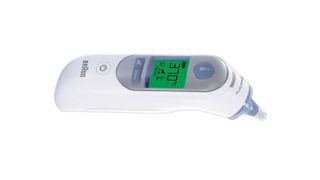
This is one of the most feature-rich digital thermometers you can buy, which is one of the reasons why it’s so hard to track down at the moment. The Braun ThermoScan 7 considers every step of your temperature reading process, making it as easy, accurate and as comfortable as possible.
While some babies and children might rebel against having a thermometer inserted into their ears, Braun’s doctor-recommended Thermoscan 7 has a wide angle probe to make accurate readings easier to achieve – so you won’t have to keep adjusting the angle and irritating your child.
Built-in sensor pointer guidance makes this even faster, and a night light makes the entire device easy to use in darker environments.
Like the Withings Thermo, the award-winning Braun Thermoscan 7 has a useful temperature memory function, which means it stores nine previous temperature readings, enabling you to track any change in temperature (see image below).
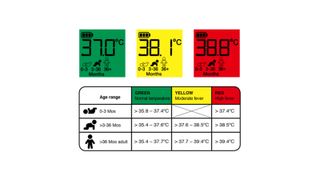
The thermostat uses age-adjustable fever guidance, based on a study commissioned by Braun to validate the age-based fever cutoff points for the AgeSmart feature utilised in the brand’s IRT 6520 Thermometer. The Thermoscan 7 takes your age into account when producing a body temperature reading, then color codes it so that you can see at a glance whether you have a fever.
4. Motorola Care+ 3-in-1 digital thermometer: Best for testing liquids
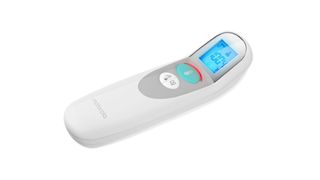
This is a very simple to use digital thermometer capable of delivering one-second temperature readings without making contact with your skin. There’s also a quiet mode (nighttime mode) for taking a person’s temperature while they’re asleep, and it can store up to 30 readings at a time to give you a clearer picture of whether a person’s fever is worsening or easing off.
The Motorola Care+ 3-in-1 Smart Thermometer is also safe for use as a water, baby food and liquid thermometer, so it’s a pretty handy device to have around. But it isn’t just for use as a baby thermometer, and can therefore be used to pinpoint a possible fever in older children and adults too. It does this via a color coded fever alert system. Green signals a healthy body temperature, while red indicates a fever.
To use the Motorola Care+ 3-in-1 Smart Thermometer, simply turn it on, hold it about an inch or so away from your forehead, and you’ll see the temperature reading displayed almostly instantly on the thermometer’s large display. If you connect it to the Motorola Hubble app you’ll also see the reading displayed there too. In the app you can then add in additional health notes to share with your doctor as needed.
You don’t even need to switch it off, as Motorola has designed it to automatically power off after use. The battery life is around a year with average use, and thanks to a low battery alert you’ll know when it’s time to switch in some fresh ones.
5. Braun No Touch + Touch: Best digital thermometer for babies
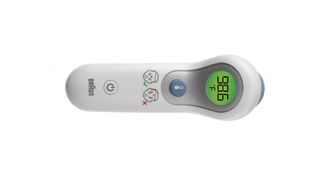
As far as thermometers go, the Braun No Touch + Touch is impressive, as it can take a temperature reading without touching a person’s forehead. Via a physical button on the thermometer you can quickly switch between contact and non-contact readings.
Non-contact temperature readings are handy if you don’t want to wake an ill baby, child or adult from a replenishing sleep and you just want an idea of how they’re doing, temperature-wise. Though for absolute accuracy, run a contact forehead temperature reading with the Braun No Touch + Touch Forehead.
Braun’s digital thermometer can also be used to measure liquid temperatures, which means you can use it to check the temperature of your baby’s bath, or even the milk they’re drinking.
Just like the Braun Thermoscan 7 further up our list of the best digital thermometers, the Braun No Touch + Touch Forehead uses color-coded temperature guidance, so you can tell quickly if you or the person you’re caring for has a fever.
There’s also probe positioning advice, and Age Precision technology to give you clearer health guidance based on the age of the person you’re taking a temperature reading for.
6. iHealth No-Touch: Best digital thermometer for zero contact readings

For a hygienic temperature reading, this digital thermometer by iHealth will quickly take your temperature without any physical contact on your body whatsoever. This not only makes it easy to use but safe too. Simply bring the thermometer within 1.18 inches of the center of the forehead and the ultra-sensitive infrared sensor will collect more than 100 data points per second for maximum accuracy.
This digital thermometer is straightforward to use with a simple single-button design and a clear LED screen, which is bright enough to read even in total darkness. Other handy features include a quiet vibrating alert, which lets you know when your reading is done.
The no-touch feature makes it ideal for use for sleeping children, or for use outdoors when a temperature quickly needs to be taken. The small device is easy to carry and is powered with 2AAA batteries.
As a company, iHealth says it is “dedicated to helping people lead healthier lives” and has donated tens of thousands of masks to more than 300 medical centers, hospitals and clinics. With this level of dedication it’s easy to put trust in the reliability of this excellent digital thermometer, which gets nearly 120,000 reviews on Amazon with an average score rating of 4.5 out of 5 stars.
7. Chooseen 8-in-1 Thermometer: Best digital thermometer for the whole family

Chooseen’s digital multi-functional thermometer goes beyond simply measuring body temperature. It includes added functionality for storing readings, and taking temperatures of rooms, objects and liquid, should you need it. This makes it ideal for checking your infant’s bath-water temperature, as well as how warm the nursery is.
Readings are taken within one second by placing the sensor on the forehead or by inserting it into the ear. A high-accuracy probe and upgraded smart chip promise accurate results. Other handy features include 35 memory recall slots, a silent mode and a fever alarm.
The battery-powered unit has a clear display and provides the readings in both Celsius and Fahrenheit, while the color temperature indicator helps you quickly see when a temperature is dangerously high, with green for normal, orange for light fever, and red for high fever.
Other key features with this digital thermometer include auto-shutoff when not in use, to ensure you save on battery power.
8. Vicks ComfortFlex V966F: Best cheap thermometer
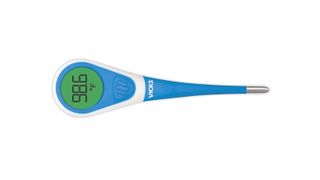
The Vicks ComfortFlex Digital Thermometer can take a body temperature reading in three different ways: rectally, orally or armpit, making it a versatile item to add to your First Aid kit.
This cheap thermometer is safe to use on children and adults, though little ones may prefer the non-invasive approach of the Withings Thermo above, or the Braun No Touch + Touch Forehead below.
The Vicks digital thermometer is lightweight and easy to handle, and comes with a probe cover and storage pouch for when you’re not using it. Although to maintain hygiene, we would recommend sterilizing the thermometer after use or wiping it with alcohol-based wipes.
Readings are accurate and easy to view on the clear digital display, though they did take a little longer (approximately 8-11 seconds) to register than readings generated by other models in our best digital thermometers guide.
If you want to take back-to-back readings for comparison, you’ll have to turn the thermometer off then on again. Certainly not a deal-breaker at this low price, but it can slow you down.
The only thing we didn’t like about the Vicks ComfortFlex Digital Thermometer is that it makes a loud beeping noise when in use. Again, not a huge problem when you consider how cheap this thermometer is.
9. iProven Clinical Basal Thermometer: Best digital thermometer for tracking ovulation
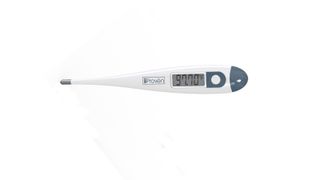
Basal thermometers take much longer to capture a reading than any other device in our guide to the best digital thermometers, but that’s pretty standard among basal readers. When it comes to tracking temperature for signs of impending ovulation, the smallest spikes in temperature make all the difference, and accurately capturing that small difference in temperature takes time. In this case, a minute.
The iProven Clinical Basal Thermometer is accurate to 1/100th degree, helping you to spot that tiny jump in temperature just before you ovulate. The thermometer sits under your tongue, toward the back, where you should leave it with your mouth closed.
The thermometer will beep once a reading has been captured, signaling the time for you to remove it. The temperature reading will be displayed on the body of the basal thermometer itself, giving you plenty of time to jot it down in your basal body temperature monitoring (BBT) notes or fertility tracker app.
At the beginning of your monthly cycle, your basal body temperature will remain fairly consistent, averaging between 97.2 and 97.6 degrees Fahrenheit. As you get approach ovulation there’ll be a dip in BBT followed by a sharp increase averaging between 0.4 to 1.0 degrees just after ovulation.
The Mayo Clinic’s basal body temperature guide provides a clear overview of BBT monitoring and when to do it (ie, as soon as you wake up) to help increase your chances of getting pregnant.
The iProven Clinical Basal Thermometer BBT-113A2A is currently in stock at Walmart and available for home delivery.
Where to buy digital thermometers online
Where to buy digital thermometers
Our market-leading price tracker software below constantly searches for the best prices on all featured digital thermometers, enabling you to quickly see which ones are available to buy.
At times, due to the huge increase in demand for thermometers during the Coronavirus pandemic, you may not see any prices listed below a product. But this can change daily as more stock arrives, so don’t give up hope.
If you want to search online in addition to using our time-saving price tracker software, here are some handy links to take you straight to the thermometer listing pages at major online retailers in both the US and the UK…
Where to buy digital thermometers for fever monitoring in the US:
- Shop digital thermometers at Walgreens
- Shop digital thermometers at Rite Aid
- Shop digital thermometers at Walmart
- Shop digital thermometers at Best Buy
- Shop digital thermometers at Target
- Shop digital thermometers at Home Depot
- Shop digital thermometers at Costco
Where to buy digital thermometers for fever monitoring in the UK:
- Shop digital thermometers at Boots
- Shop digital thermometers at Amazon UK
- Shop digital thermometers at Superdrug
- Shop digital thermometers at John Lewis
- Shop digital thermometers at Lloyds Pharmacy
- Shop digital thermometers at Chemist Direct
Why would you need to use a digital thermometer?
Why use a digital thermometer
Besides fever monitoring, these might be other reasons why you want to buy a digital thermometer. For example, you might be trying to conceive a baby and therefore want to get a better idea of when you’re close to ovulating. In that case, we’d point you towards a basal thermometer (see below), as these are designed to recognize the tiny changes in body temperature that could indicate upcoming ovulation.
Or maybe you have an ongoing health condition and need to track your temperature for several days at a time. In that case, look for the Withings, Braun Thermoscan and Kinsa Smart Thermometer models below.
It’s important to remember that even the very best digital thermometers aren’t accurate enough to base an entire medical plan upon. For expert advice you consult your doctor. A thermometer can help you get an idea of what’s going on and whether it’s wise to seek further medical help.
Depending on its design, the most effective ways to use a digital thermometer are:
- Oral (in the mouth)
- Axillary (armpit)
- Forehead
- Rectal – use a separate device for oral and rectal readings
Best digital thermometers FAQ
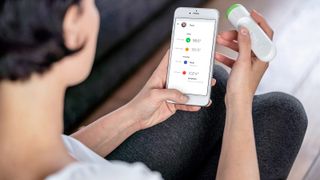
What is a digital thermometer?
An accurate reading of a person’s temperature is a vital tool in managing illness, which is where digital thermometers come in. These lightweight, handheld devices enable you to take accurate readings of your temperature, and are most commonly used to take readings either orally, via the ear or rectum, under your arms or via the forehead.
How to choose the best digital thermometer for you

The US Government has published official Coronavirus health advice, including what to do if you think you have COVID-19. The CDC has also published COVID-19 guidelines on what to do if you are sick to get the care you need and to help prevent the spread of the virus to other people in your home and community.
There are different types of thermometer, including ear thermometers, multi-use ones that can be placed in the ear, under the tongue or arms or inserted rectally, and forehead or temporal thermometers. Choosing the best digital thermometer for you is a matter of who will be using it, whether they are fine with more invasive thermometers or would prefer a non-contact thermometer, and whether you would prefer smart features too.
Ear thermometers are not suitable for use on newborns as their ear canals are too small, but they are suitable for older children and adults. Most doctors use this type of digital thermometer, and some commercially available devices come with hygienic disposable lens caps.
Forehead thermometers are newer, and some health practitioners argue over whether they are any closer to the ‘real’ temperature of your body than rectal thermometers. Some parents also worry about how accurate these types of digital thermometers are.
If you want to see a clear temperature history, choose a smart thermometer with in-app data display or a digital thermometer that is capable of recording the last several temperature readings.
What is a normal body temperature?
A normal body temperature reading in adults is around 98.6 degrees Fahrenheit (°F) or 37 degrees Celsius (°C), and will often vary by 1° to 2°F (½° to 1°C). A normal temperature is usually lower in the morning, before increasing during the day and reaching its high point late afternoon or evening.
According to the CDC advice on fever in adults, a fever is considered to be a temperature of 100.4°F (38°C) or above. If that reaches 102°F (38.8°C) or higher and at-home treatment doesn’t lower it, call your doctor or healthcare provider straight away.
The American Academy of Pediatrics (Healthy Children.org)'s fever and your baby advice state that a normal temperature reading in babies is a rectal reading of 100.4 degrees Fahrenheit (38°C) or less, or an oral reading of 99 degrees Fahrenheit (37.2°C) or less. The John Hopkins Medicine Centre also has a detailed guide on measuring your baby’s temperature.
What influences a person’s body temperature?
Your body temperature naturally changes throughout the day, and is normally lower in the morning than it is in the afternoon. Body temperature is often higher in babies and toddlers than it is in older children and adults, and for people who menstruate, their body temperature will naturally increase just before their period arrives.
Perimenopause and menopause, plus other hormonal conditions, can also influence body temperature, so your normal body temperature will naturally be a little different to the next person’s. Here are some other common influences on a person’s body temperature:
- Your age
- Your metabolism
- Your clothing
- Outside temperature
- The time of day
- Your level of physical activity
- The food and drink you have consumed
How do you take a person’s temperature?
It might not always be convenient, but ideally you should wait at least 15-30 minutes after you (or the person you’re taking a temperature reading of) have eaten or drunk any fluids, as this may affect the accuracy of the reading. The same also goes for bathing, showering or exercising, if you have been sleeping under layers, and if you have been outdoors in cold weather.
Also keep in mind that, when you’re healthy, your temperature naturally fluctuates throughout the day, reaching its high point in the afternoon or evening. Babies can also have slightly different normal temperatures to adults. When writing about thermometer use in kids, Pediatrics and Child Health explains the process of taking a temperature as follows:
- Mouth – the thermometer needs to go as far back under the left and right side of the tongue as possible. Ideally, the person won’t have eaten or drunk for 30 minutes prior to the reading being taken.
- Rectum – as close to core body temperature as you’ll get, making it a very accurate reading. But, this temperature is slow to change, so an acute fever might be missed.
- Armpit – needs to be applied for at least five minutes in order for you to gain an accurate reading.
- Ear / tympanic – temperature is not actually measured in the ear canal. Instead, it’s the infra-red light bouncing off the eardrum which is measured. As such, this can be a source of error, potentially up to a whole degree.
- Forehead / temporal – temperature is derived from an infrared recording from the temporal artery (major blood vessel) at the side of the temple.
How do you clean a digital thermometer?
Sterilizing your thermometer after each use prevents cross-contamination for other people in your household who may also need to use the thermometer. This type of frequent sharing is common during cold and flu season, and when there are global health crises such as the Coronavirus pandemic.
A fast way to sterilize your digital thermometer is to wipe it down with alcohol-based swabs. Another option is to wash the body of the thermometer with lukewarm water and soap, and rinse the tip in cold water. Don’t submerge the entire thermometer in water or pour boiling water over the tip as you could damage the sensor.
All digital thermometers come with instructions on how to use them, how to clean them after each use, and how to store them when not in use, so take a moment to read through such instructions before using your new digital thermometer.
Looking for other products to help you stay as healthy as possible during the Coronavirus outbreak? We have rounded up the best fitness trackers, the best treadmills and the best exercise bikes to help you workout at home. Don’t forget that sleep is the bedrock of good health, so now could be the perfect time to research the best mattress for your postural needs, or the best pillow for your particular sleep style.


